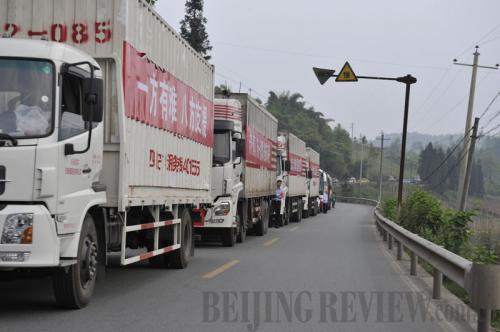|
 |
|
HELP! : Trucks loaded with relief aid are on their way to the Ya'an earthquake-hit zone in Baoxing County, Sichuan Province, on April 22 (SHI GANG) |
After a 7.0-magnitude earthquake struck in Lushan County in Ya'an City, Sichuan Province, on April 20, rescue teams rushed to the epicenter in southwest China from across the country. These teams were dispatched by the armed forces, hospitals and non-governmental organizations, or formed by individuals. Various organizations in China responded to the earthquake with unprecedented speed.
Ya'an People's Hospital is the major medical facility to treat injured quake victims.
"We responded very quickly to the earthquake. All medical workers in the hospital immediately returned to their posts and got ready for the rescue," the hospital's president Qiu Xiong told Beijing Review.
After the earthquake, the hospital promptly dispatched three medical teams to areas hardly hit by the earthquake.
Meanwhile, other relevant organizations in the country also responded to the disaster very quickly, including the Fifth Detachment of the Communications Troops under the Chinese People's Armed Police Force (CAPF), the No. 42 Hospital of the People's Liberation Army (PLA), the General Hospital of the PLA Second Artillery Force, and the Xi'an Outdoor Search and Rescue Team from northwest China's Shaanxi Province.
The emergency responses were not only much faster, but also more systematic and coordinated.
Chinese Premier Li Keqiang went to Lushan to direct rescue work. Relevant departments quickly activated their emergency plans.
Disaster relief work including road repair, emergency medical relief, victim resettlement, supply transportation, secondary disaster prevention and rescue team coordination has proceeded smoothly and in an orderly fashion. This should be credited to the government's great efforts in building the country's emergency rescue and relief system since 2008.
After the Wenchuan earthquake that hit Sichuan on May 12, 2008, emergency search and rescue teams have been set up in most counties and cities in 31 provincial-level administrative regions. The State Administration of Work Safety and the CAPF have jointly established several national- and prefectural-level search and rescue teams.
Government departments at all levels, health and epidemic prevention agencies, as well as public institutions and enterprises have all made emergency plans. Emergency response drills have been held regularly.
The nationwide emergency response network can quickly pool resources all over the country to relieve disaster. In recent years, the system has been tested and improved in a number of serious disasters such as the 7.1-magnitude Yushu earthquake in northwest China's Qinghai Province in April 2010.
Compared with the Wenchuan earthquake, the latest earthquake in Lushan caused far fewer casualties. Most of the houses in the affected areas remain standing. This once prompted people to wonder whether China has overreacted to the earthquake.
Although many buildings in the area are still standing and do not even show visible crevices on the exterior, they are still severely damaged. The interior walls and floor of many houses are either cracked or torn apart. These "standing ruins" must be torn down and reconstructed.
"After studying the site, experts concluded that the earthquake intensity in some areas reached 9 on the Richter scale. Ya'an has consolidated and renovated houses after the Wenchuan earthquake, which might have helped avoid many casualties," said Chen Yong, Deputy Director of the Ya'an Earthquake Prevention and Relief Bureau.
In addition to repairing houses, local government still faces pressure to resettle a large amount of displaced residents and prevent secondary disasters.
Drawing on experience gained in the Wenchuan earthquake, saving lives has been the top priority of the post-quake relief in Lushan, especially in the most crucial 72 hours immediately after the disaster.
To ensure medical, search and rescue teams arrive in Lushan smoothly and swiftly, a large number of non-governmental vehicles transporting other supplies such as food were blocked from Lushan in the beginning.
Later these vehicles were allowed to enter the county, yet some were delayed further by landslides, upsetting some victims of the earthquake.
In the future, the emergency response to disasters should be made more flexible so that saving lives and resettling victims can proceed more smoothly.
(Reporting from Lushan, Sichuan Province)
Email us at: wachunfang@bjreview.com | 